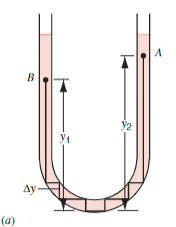On this page, we will look at fluids in Equilibrium, meaning that every portion of the fluid has both net force and net Torque equal zero.
Consider a small portion of fluid within the greater body of a homogeneous fluid. The element should be shaped like a thin disk with height
The mass of the element would be:
and the weight would be:
The disk has no horizontal forces, and since the element is at equilibrium, its vertical forces must be net zero.
Lets define some more variables:
is the pressure on the lower face. is the pressure on the upper face. We add the due to change in pressure from the height . is the upward force on the lower face since . is the downward force on the upper face for the same reason.
So, for the vertical forces:
From which we get:
We can use this equation to tell us how pressure changes from elevation above a certain point.
Info
is also known as the weight density of a fluid, the weight per volume of a fluid.
We can integrate this to find pressure at a certain point:
Liquids rarely compress, so we can keep
We can manipulate the equation further for instances where the liquid is being held in a regular container, such as a beaker:
The pressure is dependent on the depth,
For more weirdly shaped containers, we use our original equation,

For the change in pressure between points A and B, we just sum the vertical segments between A and B and multiply it by
Variation of Pressure in the Atmosphere
For gases, the density,
We can get a good idea for this by assuming density is proportional to pressure.^[Normally this is the case, but for the atmosphere temperature also matters.]
Since density is proportional to pressure:
Using this:
where
Note that the pressure drops by a factor of